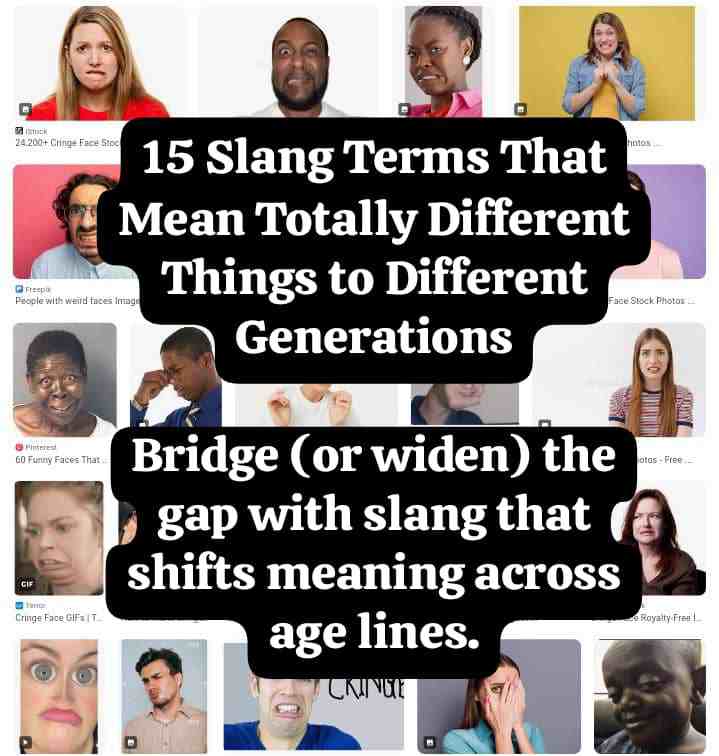Language is a living thing, it constantly changes. I’ve been watching words wobble and reinvent themselves my whole life, and every time I hear a kid use a familiar word in a new way I get a little thrill, and sometimes a little confusion.
Slang words move between groups, pick up new shades of meaning, and sometimes flip completely. This post explains 15 slang terms that mean very different things depending on the speaker’s age, region, and cultural background.
Each slang word defines the original sense, describes how the word shifted, and explains how it is heard today. Clear examples and short notes on context are included so you can decode meaning and avoid common misunderstandings.
Table of Contents
In a Nutshell
- Slang flips meaning over time; words that were negative can become praise.
- Retro usage is common: older slang often returns as irony or nostalgia.
- Cool moved from “calm/detached” to “great” or “okay.”
- Bad flipped from “negative” to sometimes meaning “impressive.”
- Sick went from “ill” to “amazing” for many younger speakers.
- Wicked can mean “evil” or “very” depending on where you’re from.
- Asking “What do you mean?” is a bridge, not a failure to understand.
- Grab the free Slang eBook and take the quick slang quiz to test your knowledge now!
1. Cool
If you grew up when cool carried a jazz-club kind of swagger; calm, collected, a little detached. Note this, over time, it’s become a shorthand for approx val: “That’s cool” can mean love, indifference, or polite agreement.
I have seen older relatives use cool in a literal way about the weather; when a teen says cool now, they might be really impressed or just acknowledging you. The clue is tone and context: excited eyes and a long vowel means praise; a clipped cool often means “fine, move on.”
2. Bad
Bad is a classic semantic plot twist. For most of history it’s meant “not good.” But thanks to pop culture, think music and film, bad can mean “tough” or “excellent.” I’ve been in rooms where a Gen Zs cheers “That move was bad!” and a parent cringes, thinking it’s criticism.
The trick: pay attention to body language and setting. In many teens scenes, bad is admiration; in formal or neutral contexts, it’s likely the old negative meaning.
3. Sick
To our grandparents, sick mostly meant someone had the flu. For surfers and skaters in the late 20th century it began to describe jaw-dropping feats; “sick trick” meant incredible.
Today Gen Alphas use sick like “awesome”, about music, fashion, or food. I once find myself smiling when a teen calls a song sick and my brain briefly searches for a thermometer. When you hear sick, check whether they’re clutching their chest or their phone; that usually tells you everything.
4. Wicked
Wicked used to live squarely in the “evil” column, straight out of older literature and sermons. In New England and some millennial slang it became an intensifier: “wicked good” = really good.
I grew up hearing both: a grandmother quoting a novel, a cousin saying “wicked awesome” after a concert. Geography plays a role: in some places wicked still reads dark; in others it’s one step from “very.” If you want to sound like you belong, pick the local vibe and run with it.
5. Rad
Rad is a pure time-capsule word from the ’80s surf and skate scene, short for “radical.” For me it always smelled of sunscreen and VHS tapes. Gen Zs today sometimes use “rad” in homage or irony; others barely touch it, preferring newer adjectives.
Older folks who were teens in the ’80s might still pepper their speech with it, which can land as quirky or charming. Using “rad” now can feel intentionally retro, a wink to a past era.
6. Groovy
Groovy is vintage flower-power: tied to records, grooves, and the whole 1960s scene. These days it’s mostly a playful throwback, used at theme parties or for comic effect.
When someone older says groovy, it can sound authentic and warm; when a teen uses it deliberately, it’s often ironic or nostalgic. Either way, groovy carries a tone of deliberate, cheerful retro-ness rather than fresh praise.
7. Hip
Hip began in jazz circles as a stamp for being in-the-know. I still use it to mean trendy, but I hear it less often among Gen Z, who favor edgier terms. Boomers and Gen Xers will still call something hip with pride: it’s a badge of cultural currency from mid-20th-century subcultures.
If you call a place “hip” today, younger people may nod politely while mentally translating to whatever the current cooler word is. It’s a good, gentle synonym for stylish when you want to sound timeless.
8. Dope
Dope has ridden a bumpy semantic road: it originally referred to drugs, then hip-hop culture reclaimed it as a word for excellence. I remember feeling the tug between those meanings when I first heard dope used as praise.
Today Gen Zs and Gen Alphas say dope for anything they love: a playlist, a look, a goal. While some older listeners might still flinch at the drug connotation. In mixed company, I recommend pairing it with a smile or a clear compliment, so people hear praise, not slang-related ambivalence.
Read Also: 26 Slang Words Brands Should Stop Misusing, And How To Use Them The Right Way
9. Gnarly
Gnarly began as a description of twisted wood or rough ocean conditions, then surfers used it to mean both dangerous and impressive. For older generations unfamiliar with board sports, gnarly can simply mean “bad” or “unpleasant.”
Among skaters, “gnarly trick” is applause: a warning and a compliment all in one. If someone calls a situation “gnarly,” double-check: are they impressed, alarmed, or both?
10. Badass
Badass is a great example of a rough word cleaned up by admiration. Where once it was an insult, someone difficult or mean, pop culture flipped it into praise for toughness and skill.
Teens these days use it to applaud boldness: a well-directed comeback, a clever performance, a daring stunt. Older relatives might still register the original bite, so using it with people who dislike coarse language can misfire. But in many online and youth spaces, badass is pure applause.
11. Lit
Lit used to mean “lit up” or intoxicated, but it exploded into modern slang that means energetic, excellent, or fun; like a party lit with excitement. I hear teenagers say “That show was lit” and picture strobe lights and non-stop energy.
Parents might hear lit and recall a different meaning or think it’s short for “literature.” It’s a great example of a word that narrowed and then broadened: from being about lighting or substance use, to describing atmosphere and intensity.
12. Fire
Fire as a compliment is a newer flip: where “on fire” used to indicate success or literal burning, younger speakers use “fire” to mean “exceptional”, especially about music, fashion, and food.
If someone calls your outfit fire, take it as high praise. Older speakers might find “fire” abrupt or prefer older adjectives like “great” or “stylish.” I love how concise it is: one syllable, big meaning. Just be careful near actual flames, literal context still matters!
13. Salty
Salty once strictly described taste or the sea, but now it commonly means bitter, annoyed, or resentful. Gen Zs most time use it when someone gets petty over a small loss: “He’s salty about losing the bet.”
Millennials might interpret it literally or not recognize the emotional shade. Salty’s a neat little emotional shorthand: it says frustration without anger. When you hear it, you can usually tell whether it’s playful ribbing or genuine irritation by how it’s said.
14. Shade
Shade began as a literal cover from the sun; lately it means a sly insult or a subtle diss, “throwing shade.” I’ve watched it go from niche queer and Black vernacular into mainstream speech.
Younger crowds use it for clever critiques: a witty line that stings without being overt. Older listeners might miss the nuance and hear only the literal sense. If you’re not sure, watch for eye-rolls or the laugh that follows; shade lands best when people both hear it and feel that tiny communal grin.
15. Cringe
Cringe is interesting because it’s not just negative: it’s reflexive embarrassment. Older folks used “cringe” to describe physical recoil; now young people use it to label anything painfully out-of-touch, often in social media contexts.
I have seen the slang cringe applied to outdated trends, awkward posts, or attempts to be “relatable” that miss the mark. The word can be dismissive in a way that widens generation gaps: something you think is harmless nostalgia might be called cringe by someone who wants newness.
If someone labels your content cringe, ask what feels off, it’s usually a teachable moment.
Why these shifts matter
Slang doesn’t only rename things, it signals who we are. When words flip meaning, they mark identity, power, and change. I think the most important skill is curiosity: rather than getting annoyed when a teen’s compliment sounds like criticism, I ask what they mean and I tell them what I remember. That’s how we trade stories and stay close.
Quick tips to bridge the gap
- Listen to tone — it tells you whether a word is praise or problem.
- Ask with warmth — “What does that mean?” invites a mini-lesson.
- Share your stories — teach the older meanings and where you heard them.
- Use context clues — people’s faces and settings reveal meaning fast.
Concluding Thought
Understanding slang changes helps people talk more clearly. These 15 examples show that tone, context, and culture shape meaning. When unsure, listen to how a word is said, check the situation, and ask for a quick explanation. Share examples or questions in the comments to help others learn too.

